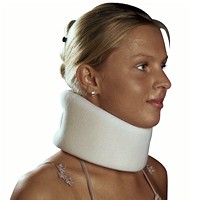Chronic Neck Pain And Breathing Problems
Chronic neck pain is a frequent musculoskeletal complaint and can lead to adaptive changes in neck region and related structures associated with breathing. Although neck pain is predominantly considered and treated in clinical practice as a neuromusculoskeletal problem, there is a close anatomical connection of the neck region with the thoracic spine which have led some researchers to believe that neck pain may lead to associated changes in thoracic spine and rib cage and consequential changes in breathing function. Let’s look into some factors involved with neck pain and breathing problems.
Neck studies have shown that muscle strength and endurance, mobility, head posture and proprioception are all affected in patients with chronic neck pain, whereas abnormal psychological states such as anxiety, depression, kinesiophobia and catastrophizing may also be present in coping with neck pain. It has been recently theorized that all of these can have their own contribution for the development of breathing problems. Changes in neck mobility, head posture and dysfunction of the local and related muscle systems are believed to lead to changes in curves, muscle imbalances and segmental instability which may affect the function of thoracic cage and rib cage mechanics related to breathing dysfunction.
 This dysfunction might be more apparent during inspiration as the common muscles of the neck region and respiration (sternocleidomastoid, scaleni and trapezius) are all inspiratory in function. The existence of psychological factors such as kinesiophobia (fear of movement) might also lead to movement avoidance further contributing to the dysfunction of neck muscles and consequentially to the potential changes in rib cage mechanics, associated neck pain and breathing problems..
This dysfunction might be more apparent during inspiration as the common muscles of the neck region and respiration (sternocleidomastoid, scaleni and trapezius) are all inspiratory in function. The existence of psychological factors such as kinesiophobia (fear of movement) might also lead to movement avoidance further contributing to the dysfunction of neck muscles and consequentially to the potential changes in rib cage mechanics, associated neck pain and breathing problems..
These changes in rib cage biomechanics could lead to associated changes of breathing muscles altering their abilities. Patients with chronic neck pain have been found to present reduction in their maximal mouth pressures. There is evidence about the strength of breathing muscles in patients with chronic neck pain. The association of breathing strength with the common musculoskeletal and psychological manifestations of patients with chronic neck pain is clearer.
Patients with chronic neck pain have reduced strength of breathing muscles. Neck muscle strength, kinesiophobia and catastrophizing are significantly correlated with breathing muscle strength, whereas pain intensity and disability are additionally associated with strength of expiratory breathing muscles. Only the strength of neck muscles remains as significant predictor of breathing weakness. Strength of neck muscles is found to be the deficit which is mostly associated with strength of breathing muscles.
Patients with chronic neck pain are found to have reduced performance of their global and local muscles. Dysfunction of these muscles is believed to lead to reduced breathing performance mainly because of a) the common function of sternocleidomastoid, trapezius and scaleni muscles on neck movement and breathing inspiration, b) changes in curves and muscles imbalances, c) segmental instability of the neck which might be also observed in thoracic spine because of muscles such as longus colli which attach in both areas and d) impairment of neck proprioceptors making it more difficult for to find the optimal alignment of the spine. These changes may lead to adapted patterns of rib cage relationships of the associated breathing muscles leading to alteration of contraction patterns. These mechanical changes of breathing muscles may lead to a permanent breathing weakness.
 Neck Traction Devices Neck Traction Devices |
 Cervical Pillows Cervical Pillows |
 Neck Support Collars Neck Support Collars |
The existence of psychological states seems to play an additional role contributing to this breathing weakness. Kinesiophobia may directly lead to reduced breathing strength due to poorer performance during the pulmonary function testing. However, its role seems to be rather indirect through a further deconditioning of the neck muscles because of prolonged neck movement avoidance. Limited neck movement can lead to deconditioning of neck muscles and adaptive changes further affecting muscles and breathing function.
Pain intensity and disability are correlated only with expiration. If the breathing weakness observed in patients with neck pain was mostly dependent on the common function of sternocleidomastoid, scaleni and trapezius in neck movement and breathing, inspiration would be expected to have a stronger association with this breathing weakness. Respiratory muscle weakness in patients with chronic neck pain cannot be mainly attributed to the common function of these muscles on both neck movement and inspiration and this breathing weakness is a multidimensional dysfunction related to a combination of biomechanical and psychological mechanisms of other neck pain problems.
Forward head posture may be associated with improved breathing strength. Although this association seems to be strange, it has been reported that children with forward head posture present increased inspiration and expirational breathing. Forward head posture can be adopted by patients with breathing problems as an attempt to increase airflow and improve breathing function. Therefore, forward head posture in patients with chronic neck pain can be viewed not only as poor neck posture, but it might be also a compensatory mechanism for improving breathing function.
Breathing weakness of patients with chronic neck pain cannot be considered as pathological, but there is an obvious dysfunction of breathing muscles which may need clinical attention.
 The breathing weakness observed in patients with chronic neck pain can importantly influence the clinical implications about the usual treatment of chronic neck pain. It can be suggested that breathing function should be also included into assessment and treatment of patients with chronic neck pain. However, further study should examine the effectiveness of additional breathing exercises as complementary to the usual treatment of patients with chronic neck pain. Once learned, coordination with specific neck exercises is recommended.
The breathing weakness observed in patients with chronic neck pain can importantly influence the clinical implications about the usual treatment of chronic neck pain. It can be suggested that breathing function should be also included into assessment and treatment of patients with chronic neck pain. However, further study should examine the effectiveness of additional breathing exercises as complementary to the usual treatment of patients with chronic neck pain. Once learned, coordination with specific neck exercises is recommended.
Chronic neck pain does not seem to be a condition related only with neuromusculoskeletal and psychological problems, but it appears to have more dimensions. Breathing function of patients with chronic neck pain can be also affected as they present with weakness of their respiratory muscles. Neck muscle dysfunction, biomechanics and psychological influences appear to be the factors that are mostly associated with neck pain and breathing problems.
- A 2014 edition of the Journal of the Medical Association of Thailand published a study on breathing re-education and motion of the cervical spine in individuals with chronic neck pain. The authors of the study noted that faulty breathing may cause neck pain symptoms. This study has determined the effects of respiratory muscle reeducation on neck pain symptoms and respiratory function. The results indicted improved range of motion in the neck after deep breathing training.
- A 2020 study in Annals of Rehabilitation Medicine found that thoracic spine mobility was reduced in patients with chronic neck pain during forced respiration and was associated with respiratory strength. The authors indicated that chronic neck pain can contribute to changes in biomechanics of the cervico-thoracic spine as well as the rib cage.
- A 2023 study in Musculoskeletal Science & Practice found that women with chronic neck pain have altered diaphragm function and targeting this may improve the rehabilitation process.
- A 2024 study in Musculoskeletal Science & Practice found patients with chronic neck pain suffered impaired diaphragm function, respiratory muscle strength, and pulmonary function. Smaller diaphragm thickness changes displayed poorer pulmonary function and reduced maximal expiratory muscle strength.
